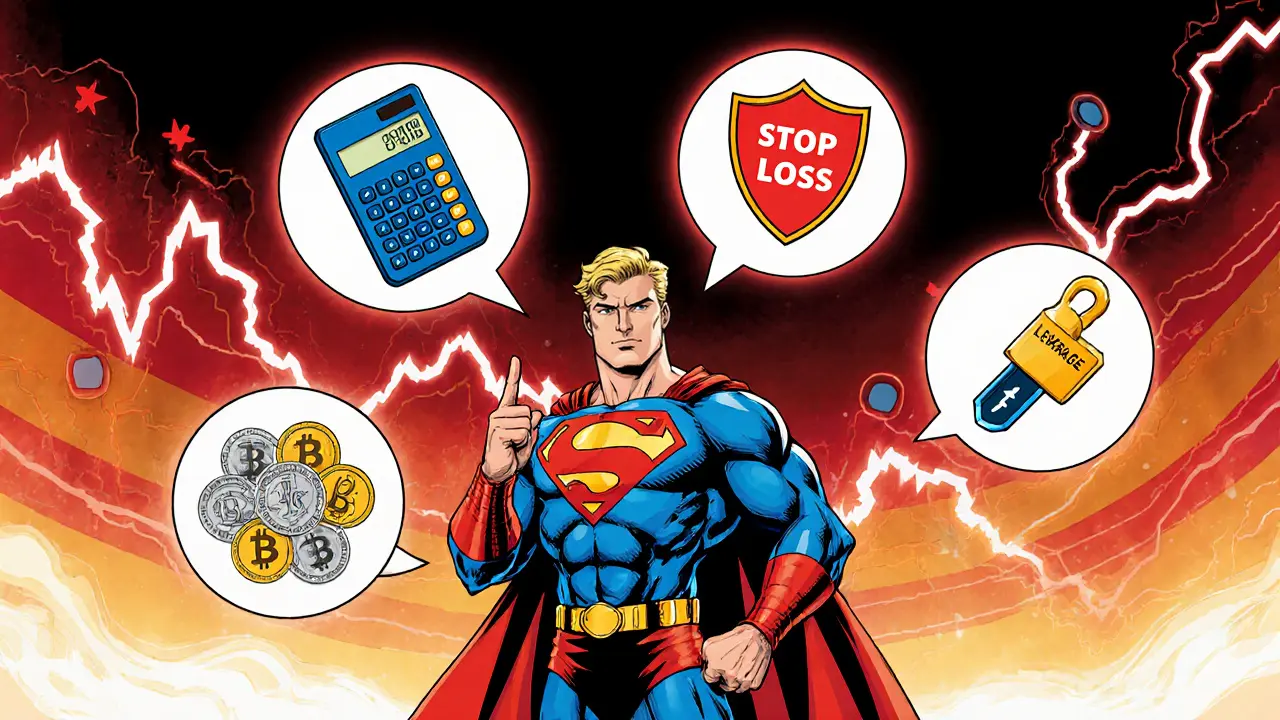Crypto Trading Risk Management: Core Principles & Best Practices
Crypto Position Sizing Calculator
Calculate your maximum trade size based on your risk tolerance. Enter your account size, risk percentage, and stop-loss distance to see exactly how much you should invest.
When crypto markets swing 30% in a day, the difference between a thriving trader and a busted account often boils down to one thing: crypto risk management. Below you’ll find a hands‑on playbook that takes the abstract idea of risk control and turns it into concrete actions you can apply right now.
Key Takeaways
- Limit each trade’s risk to 1‑2% of your total capital.
- Use a risk‑to‑reward target of at least 1:2.
- Combine position sizing, stop‑losses, diversification, and leverage caps for a layered defense.
- Review your portfolio daily; the market never sleeps.
- Leverage psychology: stick to the plan, especially during FOMO spikes.
Crypto Risk Management is the systematic process of identifying, measuring, and limiting potential losses while trading digital assets. It blends traditional finance principles with crypto‑specific tweaks for 24/7 markets, high volatility, and the lack of consumer‑grade insurance. This guide walks you through the five‑step framework, the core techniques every trader should master, and the tools that make disciplined trading possible.
The Five‑Step Risk Management Framework
- Identify Risks: Look at market, technical, operational, and regulatory threats that could hit your positions.
- Analyze Impact: Estimate how much each risk could cost you in dollars and percentage of equity.
- Assess & Prioritize: Rank risks by severity - high‑impact, high‑likelihood events get top priority.
- Treat Risks: Choose to avoid, reduce, transfer, or accept each identified risk.
- Monitor & Review: Track performance, adjust stop‑losses, and revisit allocations at least once per day.
Core Techniques You Can Deploy Today
1. Position Sizing
Position Sizing determines how many units of a crypto you buy or sell based on how much you’re willing to lose on that trade. The standard formula is:
Position Size = (Account Size × Risk per Trade) ÷ Stop‑Loss Distance
Example: With a $10,000 account, a 1.5% risk per trade, and a stop‑loss 5% away, the size is ($10,000 × 0.015) ÷ 0.05 = $3,000 worth of the asset. This keeps any single loss under $150, preserving capital for the next opportunity.
2. Stop‑Loss Orders
Stop‑Loss Order is an automatic instruction that closes a position when price hits a predefined level. Two common flavors work well in crypto:
- Fixed Stop‑Loss: Set at a technical support level (e.g., a recent swing low).
- Trailing Stop: Moves up as price rises, locking in gains while still protecting downside.
Never place a stop‑loss at a round number like $20,000 for Bitcoin unless it aligns with a clear chart pattern - otherwise you risk being taken out by normal market noise.
3. Diversification
Diversification spreads capital across unrelated crypto assets to reduce correlation risk. A practical rule of thumb is:
- Don’t exceed 5‑10% of the portfolio in any single coin.
- Allocate only 1‑2% to high‑risk, low‑cap altcoins.
For a $10,000 portfolio, you might hold 40% in Bitcoin, 30% in Ethereum, 15% in a basket of DeFi tokens, 5% in a stablecoin for liquidity, and keep the remaining 10% in cash or short‑term “opportunity” funds.
4. Risk‑to‑Reward Ratio
Target a minimum of 1:2, meaning you aim to earn at least twice what you risk. If you risk $100 on a trade, set a profit target of $200 or more. This ratio lets you stay in the black even with a 40% win rate, because the winning trades outweigh the losers.
5. Leverage Management
Leverage amplifies both gains and losses. In crypto, many platforms offer up to 100×, but evidence shows that leverage above 3:1 dramatically increases the chance of liquidation. Stick to 1‑2× for spot exposure and no more than 3× for futures, especially if you’re still building discipline.

Building Your Personal Risk Management Plan
- Set a maximum risk per trade (1‑2% of total equity).
- Calculate position size using the formula above.
- Identify entry point, stop‑loss level, and profit target to achieve at least 1:2 RR.
- Apply diversification limits across your watchlist.
- Choose leverage settings that match your risk appetite.
- Record every trade in a journal - note emotions, rationale, and outcome.
- Review the journal weekly to spot patterns of rule‑breaking.
Having a written checklist turns “I think I’ll hold this longer” into a conscious decision you can test against your plan.
Tools & Resources to Enforce Discipline
- Position Size Calculators - free web tools or mobile apps that ask for account size, risk %, and stop‑loss distance.
- Portfolio Trackers - CoinTracker, Blockfolio, or Delta for real‑time exposure monitoring.
- Hardware Wallets - Ledger Nano X or Trezor Model T to protect private keys.
- Charting Platforms - TradingView’s alert system for automatic stop‑loss and trailing‑stop triggers.
- Risk Analytics - Exchange‑based tools (e.g., Binance’s “Risk Dashboard”) that show margin‑usage and liquidation risk.
Common Pitfalls & Psychological Traps
- FOMO Over‑leveraging: Chasing a 20% rally with 10× leverage usually ends in a margin call.
- Moving Stop‑Losses out of fear, which reverses the protection they’re meant to provide.
- All‑in on a Single Asset: Even Bitcoin can drop 30% in a week - diversification is your safety net.
- Ignoring Operational Risks: Storing funds on an exchange exposes you to hacks; hardware wallets mitigate this.
- Regulatory Shock: Sudden bans (e.g., China 2021) can wipe out liquidity; keep a portion in jurisdictions with clearer crypto policies.
Sample Risk Management Checklist
- ✅ Determine account size and set 1‑2% risk per trade.
- ✅ Calculate position size before each entry.
- ✅ Place stop‑loss at a technical support level.
- ✅ Verify profit target achieves at least 1:2 risk‑to‑reward.
- ✅ Confirm asset does not exceed 10% of portfolio.
- ✅ Ensure leverage is ≤3× for futures.
- ✅ Record trade rationale in journal.
- ✅ Review portfolio performance daily.
Comparison of Core Risk Controls
| Technique | How It Works | Typical Use | Pros | Cons |
|---|---|---|---|---|
| Position Sizing | Calculates trade size based on account risk and stop‑loss distance. | Every trade. | Limits loss magnitude; scalable. | Requires accurate stop‑loss placement. |
| Fixed Stop‑Loss | Pre‑set price level that triggers a market order. | Highly volatile assets. | Simple, instant protection. | Can be hit by short‑term noise. |
| Trailing Stop | Stop moves up with price, keeping a set distance. | Long‑term uptrends. | Locks in gains automatically. | May trail too tightly on choppy markets. |
| Diversification | Spreads capital across uncorrelated coins. | Portfolio construction. | Reduces correlation risk. | May dilute high‑alpha opportunities. |
| Leverage Cap | Sets maximum borrowing ratio. | Futures/margin trading. | Controls exposure blow‑up. | Limits upside potential. |
Mini FAQ
How much of my portfolio should I risk on a single crypto trade?
Most professional traders limit each trade’s risk to 1‑2% of total equity. This protects the account from a series of losing trades.
What’s a realistic risk‑to‑reward ratio for Bitcoin day‑trading?
A 1:2 or higher ratio works well. For example, risk $200 to aim for $400 profit. Even with a 45% win rate, this ratio yields positive expectancy.
Can I rely on exchange insurance instead of my own risk controls?
No. Most exchanges offer no guarantee for trading losses, and insurance typically covers only hacks, not market moves. Personal risk management remains essential.
How often should I rebalance my crypto portfolio?
A monthly review works for most traders. If an asset’s weight exceeds its target by more than 2‑3%, consider trimming back.
Is using a hardware wallet part of risk management?
Absolutely. Storing private keys offline removes the operational risk of exchange hacks and phishing attacks.
Implement these principles, keep a journal, and treat every trade like a small experiment. Over weeks and months the discipline you build will safeguard your capital and let the upside of crypto markets work for you.









Risk management is the only safety net!!!
Oh, the sheer poetry of a well‑crafted risk plan! It’s like a lighthouse in the stormy seas of crypto, guiding you away from the jagged rocks of ruin. You see, every trader is a sailor, and every trade a daring voyage into uncharted waters. Without a compass-i.e., a solid risk calculator-you’re just drifting, hoping the currents won’t swallow you whole. The 1‑2% rule is the modest helm, keeping the ship steady while the winds of volatility howl. Position sizing? That’s the ballast, preventing capsizing when the tide turns. Stop‑loss orders are your lifelines, cutting the rope before you’re pulled under. Diversification spreads the load, like a crew sharing the oars, so no single rower can sink the vessel. Leverage, when tamed, can give a splash of speed, but unchecked it becomes a reckless cannonball. The risk‑to‑reward ratio is your treasure map, promising gold if you follow the path without succumbing to greed. Daily reviews? They’re the nightly logbook entries, reminding you of lessons learned and errors made. Psychology, the hidden wind, can lift you to glory or drag you into despair-stay disciplined! The checklist at the end of the guide reads like a sacred mantra, each tick a prayer for safety. Remember, the market never sleeps, but your brain needs rest; schedule breaks, or you’ll trade on fumes. In the end, risk management isn’t a constraint, it’s the very freedom that lets you explore the crypto frontier with confidence.
Alright, let me be blunt-this guide is solid but feels like a lecture from a robot. I get the basics, but where’s the spice? Some real‑world war stories would make it pop! Still, the checklist is useful, so I’ll keep it handy.
Yo, this whole "1‑2% per trade" nonsense is just a fancy excuse to keep newbies from making big gains. If you want real profit, you need to risk more, not hide behind tiny percentages. Also, the whole "stop‑loss" idea is a snake oil trick; markets rip you out no matter what. Stop reading this safe‑space nonsense and start taking real risk!
I appreciate how thorough this post is-especially the emphasis on daily reviews. It’s easy to get lost in the hype, so having a clear checklist really helps keep things grounded. Also, the hardware wallet tip is a great reminder for security. Thanks for sharing!
Look, man, they don’t tell you the real truth-big exchanges are a front for a hidden agenda. All that “hardware wallet” stuff is just a distraction while they siphon off funds. Trust no one, especially those crypto “gurus”.
From a technical standpoint, the position sizing formula is spot on-using account equity multiplied by risk% over stop‑loss distance yields a scalable allocation. For example, with a $15k portfolio, a 1.5% risk and a 4% SL gives a $562.5 position, preserving capital while maintaining exposure. Also, employing trailing stops can dynamically lock in profits without manual intervention, which is essential in high‑frequency market conditions.
Yeah, sure-just another excuse for the “big guys” to keep us in the dark. They want us to think we’re in control, but the system’s rigged.
It’s simple: if you don’t plan, the market will plan for you. Risk management is just common sense, but the powers that be try to hide it.
Whilst the preceding assertion holds merit, it is imperative to underscore the necessity of systematic documentation. A rigorously maintained journal not only facilitates introspection but also cultivates discipline, thereby attenuating cognitive biases that may otherwise impair strategic execution.
Stick to the 1‑2% rule, keep leverage low. No excuses.
This is just basic stuff, no need to overthink it.
Well, look who finally discovered the concept of “risk management”. Congratulations on reinventing the wheel-perhaps next you’ll tell us how to breathe.
Seriously, this guide is primitive. Anyone who follows a 1‑2% rule is destined for mediocrity. If you want to dominate, you need aggressive sizing and bigger leverage. Stop playing it safe.
Hey folks, just wanted to add that a good entry point is crucial. I always look for confluence of support levels before I set a trade. Also, double‑check your stop‑loss placement – a typo can cost you a lot!